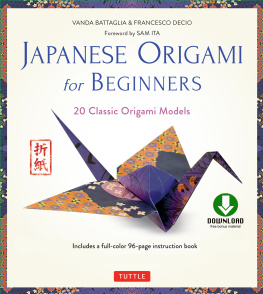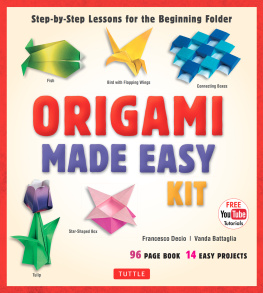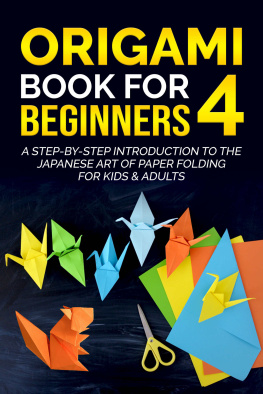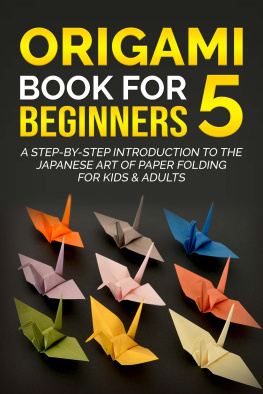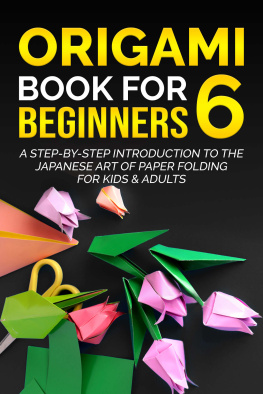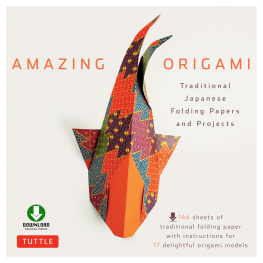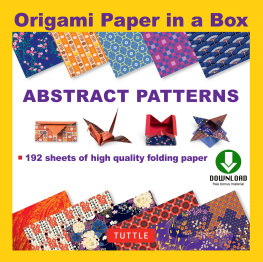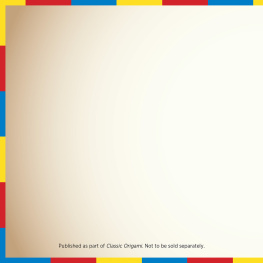Battaglia Vanda - Japanese Origami for Beginners Kit
Here you can read online Battaglia Vanda - Japanese Origami for Beginners Kit full text of the book (entire story) in english for free. Download pdf and epub, get meaning, cover and reviews about this ebook. year: 2015, publisher: Tuttle Publishing, genre: Religion. Description of the work, (preface) as well as reviews are available. Best literature library LitArk.com created for fans of good reading and offers a wide selection of genres:
Romance novel
Science fiction
Adventure
Detective
Science
History
Home and family
Prose
Art
Politics
Computer
Non-fiction
Religion
Business
Children
Humor
Choose a favorite category and find really read worthwhile books. Enjoy immersion in the world of imagination, feel the emotions of the characters or learn something new for yourself, make an fascinating discovery.
- Book:Japanese Origami for Beginners Kit
- Author:
- Publisher:Tuttle Publishing
- Genre:
- Year:2015
- Rating:3 / 5
- Favourites:Add to favourites
- Your mark:
- 60
- 1
- 2
- 3
- 4
- 5
Japanese Origami for Beginners Kit: summary, description and annotation
We offer to read an annotation, description, summary or preface (depends on what the author of the book "Japanese Origami for Beginners Kit" wrote himself). If you haven't found the necessary information about the book — write in the comments, we will try to find it.
Japanese Origami for Beginners Kit — read online for free the complete book (whole text) full work
Below is the text of the book, divided by pages. System saving the place of the last page read, allows you to conveniently read the book "Japanese Origami for Beginners Kit" online for free, without having to search again every time where you left off. Put a bookmark, and you can go to the page where you finished reading at any time.
Font size:
Interval:
Bookmark:
 VANDA BATTAGLIA & FRANCESCO DECIO
VANDA BATTAGLIA & FRANCESCO DECIO
Foreword by SAM ITA
Photography by ARALDO DE LUCA 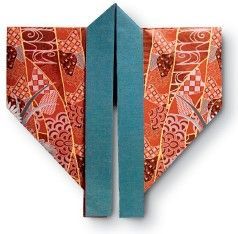
TUTTLE Publishing
Tokyo | Rutland, Vermont | Singapore



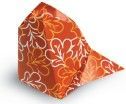


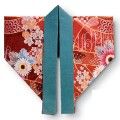
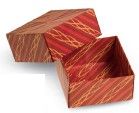












 How to Download the Bonus Material of this Book.
How to Download the Bonus Material of this Book.1. You must have an internet connection. 2. Click the link below or copy paste the URL to your web browser. http://www.tuttlepublishing.com/japanese-origami-for-beginners-kit-downloadable-cd-content For support email us at . Preface I grew up in a rural area of the United States.
There was no Japanese community. When I was four or five years old, my grandmother sent care packages from Seattle to my family, containing items such as soy sauce, dried miso, mushrooms, and various pickled vegetables or plums. Sometimes these packages would include a pack of origami paper. They always gave instructions for the same half dozen traditional models. We also had a fairly basic book of origami birds. At the time, I found some of these models very difficult and confusing.
Others, easy enough, yet the finished product was unsatisfying. A few seemed to have a magical quality. The resulting object was greater than the sum of its folds. I practiced these models over and over, until I understood their logic, and could recreate them from memory with my eyes closedoften from school paper. As an adolescent, I did very little origami. As an adult, sometimes Id buy an origami book in an airport book store or a gift shop.
Id try folding a model or two from it. While I had neglected it, origami was growing at a tremendous pace! Perhaps, because I began folding at such an early age, I had never considered the creative aspects of origami. Each model I had casually folded was the result of someone elses experimentation, decisions, and careful documentation. I joined a folding group. We meet periodically at coffee shops in New York to talk origami, and fold. We fold everything; modulars, tessellations, animals, objects, furniture, etc.often until the place closes.
Some of my origami friends began folding from diagrams as children, just as I did, except they never stopped. They travel around the world attending origami conventions, inventing, and contributing models to publications. My newfound awareness of this expansive world of origami gives me an even greater appreciation for some of the traditional Japanese models, which undeniably inform and inspire their beautiful work. Occasionally, I am invited to teach origami to groups of people. Whether they are graduate students at elite universities, or young children in a community center, they all seem to progress through similar degrees of frustration, determination, satisfaction, and delight. Some of the traditional models still popular around the world today were only transmitted through oral traditions for hundreds of years.
Perhaps, origami holds the key to some sort of universal creative potential. I am asked at times if making pop-up books, my occupation, is related to origami. My answer is yes. While on the surface, they both involve folding paper; on a deeper level, I believe origami holds relevance to all artists. Perhaps my experience of learning traditional models as a young child helped me take to paper engineering early in my career. As pop-up books have become more and more sophisticated, there is always the temptation to try forcing paper to my will.
More often than not, I find the paper will rebel, and produce results that are cluttered, frivolous, or not properly functional. Traditional origami serves as a reminder of efficiency and elegance, using the properties of the paper to express the model. Ive heard that Michelangelo described sculpting as a process of freeing the model from a block of marble. Similarly, Yoshizawa spoke of the process of folding origami as an embryo developing, maturing, and emerging. I still find that folding paper relaxes the mind, and nurtures the soul. This book contains a great deal of information, and some of the most important Japanese traditional models.
Whether it is your introduction to origami, or you are already well along on your journey, I hope you will be inspired by its contents. Happy folding.
Sam Ita
www.samita.us
Font size:
Interval:
Bookmark:
Similar books «Japanese Origami for Beginners Kit»
Look at similar books to Japanese Origami for Beginners Kit. We have selected literature similar in name and meaning in the hope of providing readers with more options to find new, interesting, not yet read works.
Discussion, reviews of the book Japanese Origami for Beginners Kit and just readers' own opinions. Leave your comments, write what you think about the work, its meaning or the main characters. Specify what exactly you liked and what you didn't like, and why you think so.


